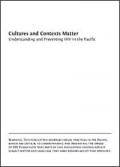Publications - Released in 2007
The HIV epidemiological situation varies greatly within and between Pacific Island countries and territories (PICT), with epidemics increasing in different places at different speeds and with different intensities. By the end of 2004, many countries were identified as low prevalence epidemics reporting less than 10 HIV infections (e.g., American Samoa, Cook Islands, Nauru, Solomon Islands, Tuvalu, Vanuatu, and Wallis and Futuna). While statistics of person living with HIV (PLWH) might appear small in many countries, these can reflect high rates of infection because of their tiny populations—and the potential impact can be great. As Jenkins (2005) explains, “the distribution of recorded infections might be viewed in different ways. The ‘cumulative incidence per 100,000’ is a good indicator of the potential impact of HIV on the local population. Even small numbers of cases in small populations (e.g., Tuvalu), particularly if found among young working men, can have a devastating impact at the local level.” Only nine people in Tuvalu have been diagnosed with HIV. However, with a population of only 9,600, the rate of infection in Tuvalu is close to that of French Polynesia and Guam, which have some of the highest numbers of HIV infections in the Pacific outside of PNG.
Downloads
Organizations
- Asian Development Bank (ADB)






